Feeding ducks should involve not only the use of commercially manufactured feed, but fresh greens, vegetables, and foraged protein from insects and tadpoles. Ducks are incredibly economical to feed while maintaining proper nutrition levels, especially if the flock is permitted to free range.
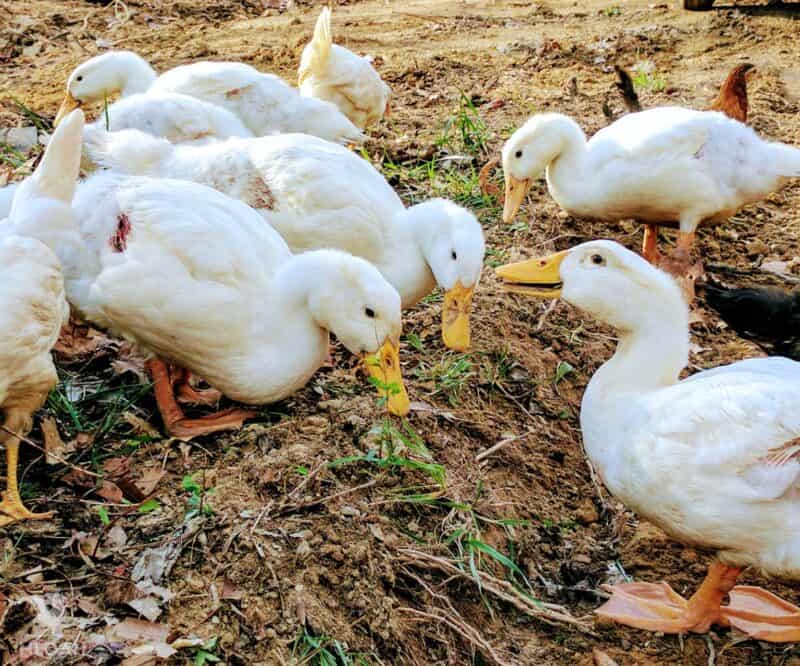
Ducks, like chickens, are omnivores. They will avidly consume protein foraged while free ranging, as well as healthy treats that contain protein.
Fresh vegetables and fruits are also a favorite snack, but they cannot eat everything we humans enjoy – nor should a high percentage of their diet be composed of even healthy snacks.
Where and how you homestead will likely greatly impact how you not only raise but feed your duck flock, as well.
Rural homesteaders most often allow their duck flocks to free-range for most of the day on and around a pond. The ducks in a scenario like this have free access to protein-rich bugs and fresh greens growing from the ground.
In a small town or suburban backyard, a duck flock can still free-range for fresh greens and bugs in the soil and from a small decorative garden pond or plastic baby pool.
These small water sources will not offer as many protein-foraging opportunities as a true pond. The small lizards, tadpoles, slugs, and snails that live in and around ponds are a delicacy to ducks of both domestic and wild varieties.
Ducks that are raised entirely or almost solely in a coop and run or duck house environment will rely more on manufactured feed to garner all of their necessary nutrients.
Infusing more natural offerings into their diet can still be accomplished by rotating edible landscaping into the flock housing quarters.
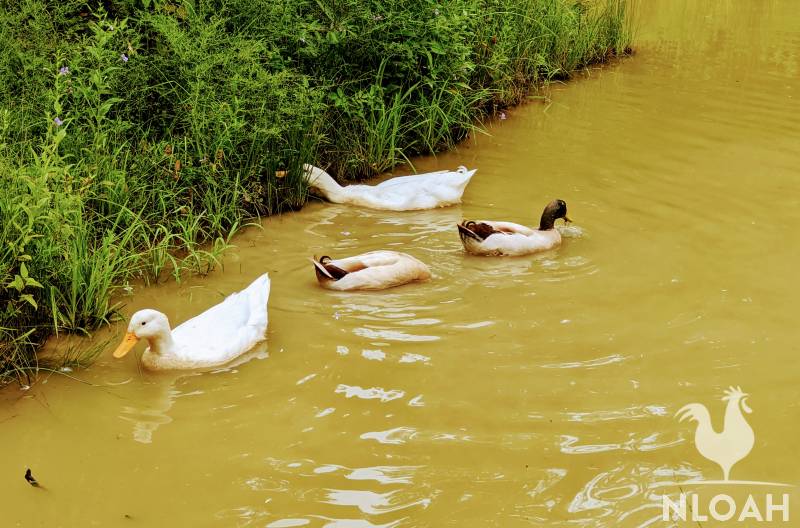
Some of the most nutrient-rich greens and vegetables that can be grown inside of a duck run to supplement their diet include zucchini, leafy greens, and broccoli. Creating a compost pile that you start a worm colony inside.
Poultry Feed Types
Chick Starter
Commercially manufactured feed of this type is designed to feed baby chicks, but it can also be fed to ducklings as long as the non-medicated version is used. Young poultry birds can more easily digest this type of food.
Crumble Feed
Crumble feed is softer than pellet feed yet denser than chick starter. Although some keepers worry about crumble feed being a choking hazard, I‘ve never experienced any problems using this with my young or mature poultry birds.
Layer Feed
This heavier and larger type of poultry bird feed is designed for laying hens but can be consumed by both drakes and roosters. Feed of this same weight and shape also comes described as a “breeder” feed.
Mash Feed
Poultry bird feed of this type is a mixture of traditional chicken scratch and crumble feed. It is a granular feed that is softer in density than a layer or breeder feed. This is a favorite type of feed of many of our ducks, chickens, and guinea birds.
But, our ducks that do not like this feed hate it and will leave it laying in their feeder for days and choose to only free range for their dinner until I offer up a different type of feed that is more to their liking.
Duck Feeding Guide By Age
Hatch To Three Weeks Old
Using the crumble version of waterfowl or non-medicated chick starter is best for newly hatched and very young ducklings. The crumble starter feed has an increased level of protein designed just for developing poultry birds.
Typically, starter crumble feed has a ratio of 18% to 20% protein. But, as already noted, chicken non-medicated starter doesn’t have the recommended levels of niacin that is best for ducklings.
In all my years of keeping ducks, I have never purchased waterfowl feed. I use non-medicated chick starter and add more niacin to their diet, as well as immune system-boosting herbs.
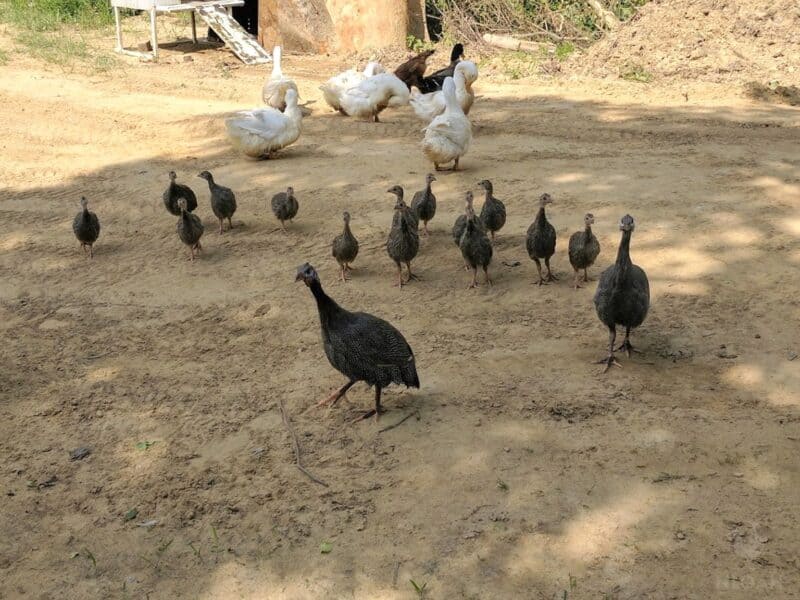
Three To 20 Weeks Of Age
Once ducklings have reached this milestone age they can transition to a grower style of feed. This type of poultry bird feed is designed for pullets – young chickens. The protein level in most brands of grower feed is roughly 15 percent.
20 Weeks And Up
Maturing ducks can be fed either a breeder poultry bird feed or more commonly a layer-style poultry bird feed. Feed of this type usually comes in either a mixed grain or pellet form.
Grit
In addition to free-range food and/or commercially manufactured ducks, just like chickens, also need grit in their diet on a daily basis. The grit helps the poultry birds to properly digest their food and calcium to their diet to help produce sturdy egg shells.
Oyster shell is a type of poultry bird grit you can purchase at an agricultural supply store. If the duck egg shells are feeling pitted or have a thin feel to them, consider adding a pinch of oyster shell into the daily feed ration to boost calcium intake.
Free-range birds will garner enough sand and rock while foraging to typically help prevent this eggshell issue from happening. Crushing up the duck hen’s own eggshells and sprinkling them onto their feed can also accomplish this same goal.
Feed Quality
Purchasing only quality feed is the first essential step in raising healthy ducks, but storing it properly is equally important.
Feed bags should only be stored in dry areas off of the ground so the content inside is not exposed to excess moisture which will allow mold and mildew to grow.
Storing duck feed in tubs or barrels with a firm fitting lid will also help deter insects and rodents from contaminating it. For optimal results, use feed by the manufacturer’s recommended “best by” date or within three weeks if stored in the bag and not in an airtight container.
Never feed ducks (or any livestock) feed that is moldy, smells sour, is damp, or has rodent droppings in the mix. Dispose of the feed immediately or attempt to return it to the store if the bag was degraded upon opening.
Feeders
There are multiple types of duck feeders. Broadcasting feed onto the ground like our pioneering ancestors did for chickens is one option, but perhaps not the best one.
Ducks have bills and not pointy beaks, making picking up small bits of feed more difficult. Also, feed broadcast onto the ground could contaminate the daily ration of the ducks.
Using a shallow rubber livestock tub, a galvanized metal tub or even a plastic food storage bowl can work just fine as a duck feeder.
When you are feeding a large flock of ducks using a feeder tray with separated openings to feed one duck in each section, or a DIY wood or plastic PVC pipe trough can also keep duck feed clean as the poultry birds dine.
Water Is Important, Too
Ducks not only need water to swim in but also to properly digest their food. Ducks drink a minimum of 1 quart of water per day – but usually more. To properly wash down the feed and foraging material that they eat, ducks need clean water to drink at all times.
When my free-ranging flock of 12 ducks has to remain in the run for a single day, they typically empty a 5-gallon waterer, along with the water they drink from their plastic baby pool:
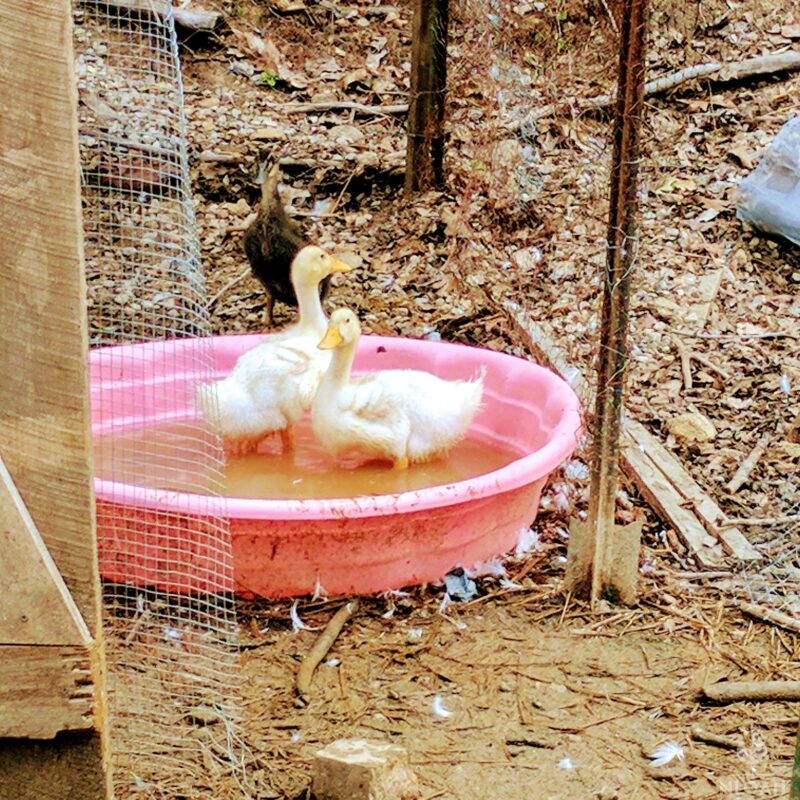
You can provide water to ducks in an open rubber or galvanized metal tub or in a closed-top waterer with drinking fountain ends. These type of waterers can be placed on the outside of the coop or hung from a board so only the fountain is reachable by the ducks – or chickens.
A galvanized metal tub will eventually rust and a plastic can (will, might be a better term) crack over the winter from freezing and thawing.
I prefer to use the plastic closed top waterers because the water inside stays far cleaner than that poured into rubber tubs that the ducks will dip their feet and bills into.
But, I insulate the outside of the closed-top plastic waterers with straw bales during the winter and float salt water-filled bottles inside during the winter to delay cracking as long as possible – keeping a backup waterer around to replace a cracked waterer is highly recommended.
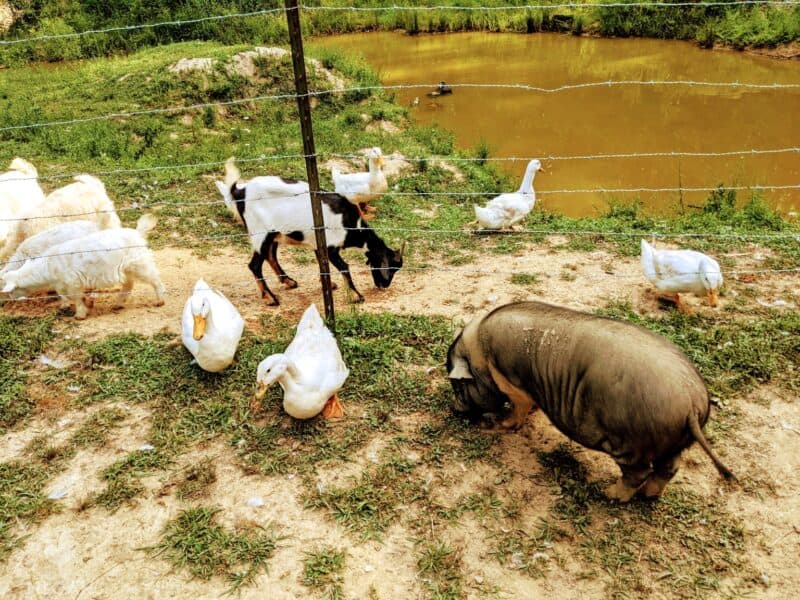
Duck Foraging Favorites
- Tadpoles
- Slugs
- Snails
- Small Lizards
- Worms
- Wild Berries
- Small Fish
- Aquatic Plants
- Grass
- Fish Eggs
- Crawdads
- Mollusks
- Algae
- Small Crustaceans
- Wild Fruit
Safe And Healthy Treats For Ducks
Treats, even safe and healthy ones, should only comprise 10 percent or less of a duck’s diet and never be offered until after the poultry birds have eaten their standard feed or free-ranging for a decent meal.
- ✅ Lettuce – ducks like Iceberg lettuce but it does not contain any lasting nutrients
- ✅ Cucumbers
- ✅ Broccoli
- ✅ Corn – cooked or cracked
- ✅ Kale
- ✅ Peas
- ✅ Beans – cooked
- ✅ Pumpkin
- ✅ Grapes
- ✅ Apples – cored, sliced, and seeds removed
- ✅ Berries – strawberries, raspberries, blueberries, blackberries, and black raspberries are frequent favorites
- ✅ Watermelon
- ✅ Bananas
- ✅ Cantaloupe
- ✅ Pasta – cooked
- ✅ Oatmeal – cooked or uncooked
- ✅ Bread – as a rare treat in very small amounts
- ✅ Rice – cooked
- ✅ Brewer’s Yeast
Using healthy treats to train the duck flock for free-ranging put up and turn out purposes and to gentle them so for health checks and injury tending is wise. Yet, the treats should still be given in only small amounts so their diet remains a healthy one.
Unsafe Foods To Never Feed Ducks
- ❌ Chocolate
- ❌ Popcorn
- ❌ Caffeine
- ❌ Onion
- ❌ Garlic
- ❌ Avocado
- ❌ Spinach
- ❌ Potato Chips – and other salty junk food
- ❌ Peanuts
- ❌ Citrus Food – it disrupts a duck’s ability to absorb calcium properly
- ❌ Potatoes
- ❌ Green Tomatoes – The solanin in them can cause scours, heart failure, and kills red blood cells
- ❌ Eggplant
- ❌ Moldy Food of any type
- ❌ Rhubarb – Plant leaves contain oxalic acid that will thin egg shells and may be toxic to ducks
- ❌ Milk
- ❌ Cheese
- ❌ Cottage Cheese
- ❌ Sour Cream
- ❌ Cream Cheese
Any allergic or toxic reaction a duck may have after consuming any of these foods might not be visible or even immediate. A build-up of harmful acids in a duck could take weeks or months to be irreparably terminal.
Poisoning symptoms may be apparent after a duck has consumed one of the foods on this list other harmful food may include visceral gout, poor egg quality, convulsions, reduced egg production, hemorrhaging, kidney failure, scours, congestion, or rapid heartbeat.
FAQ
Can Ducks Eat Chicken Feed?
Ducks can eat chicken feed, but ducklings cannot eat medicated chick starter feed. Ducks can also eat a special waterfowl style of pellets, but they are typically hard to find in rural and small town areas.
Even though ducklings can eat non-medicated chick feed they need more niacin than either baby or young chicks.
Supplementing non-medicated chick starter feed with a little brewer’s yeast (about 5 percent of their daily feed ration) or other duck-safe niacin-rich foods cut into small bits for the ducklings to consume will fulfill this vital dietary need.
How Much Should You Feed A Duck?
How much feed a duck should consume on a daily basis will depend on both their size and age. Typically, ducks eat approximately six to seven ounces (170 to 200 grams) of food daily once mature.
If you are raising a particularly large duck breed, like the Jumbo Pekins, the feed ratio should be increased by an ounce or two.
When raising ducks not just for eggs but for meat as well, the same several ounce increase of feed with the addition of the opportunity to free range for added protein is highly recommended.
The Wrap
Following a healthy and proper feeding routine will help keep the duck flock happy, and healthy, and produce quality eggs for the homestead. Remain vigilant for signs of uneaten feed in the feeder, it could be a sign of duck illness.
Expect some possible light scours or unused feed for a few days to a week if you decide to switch either brand or type of feed. It can take a little while for a duck’s digestive system to adapt to a rapid dietary change.
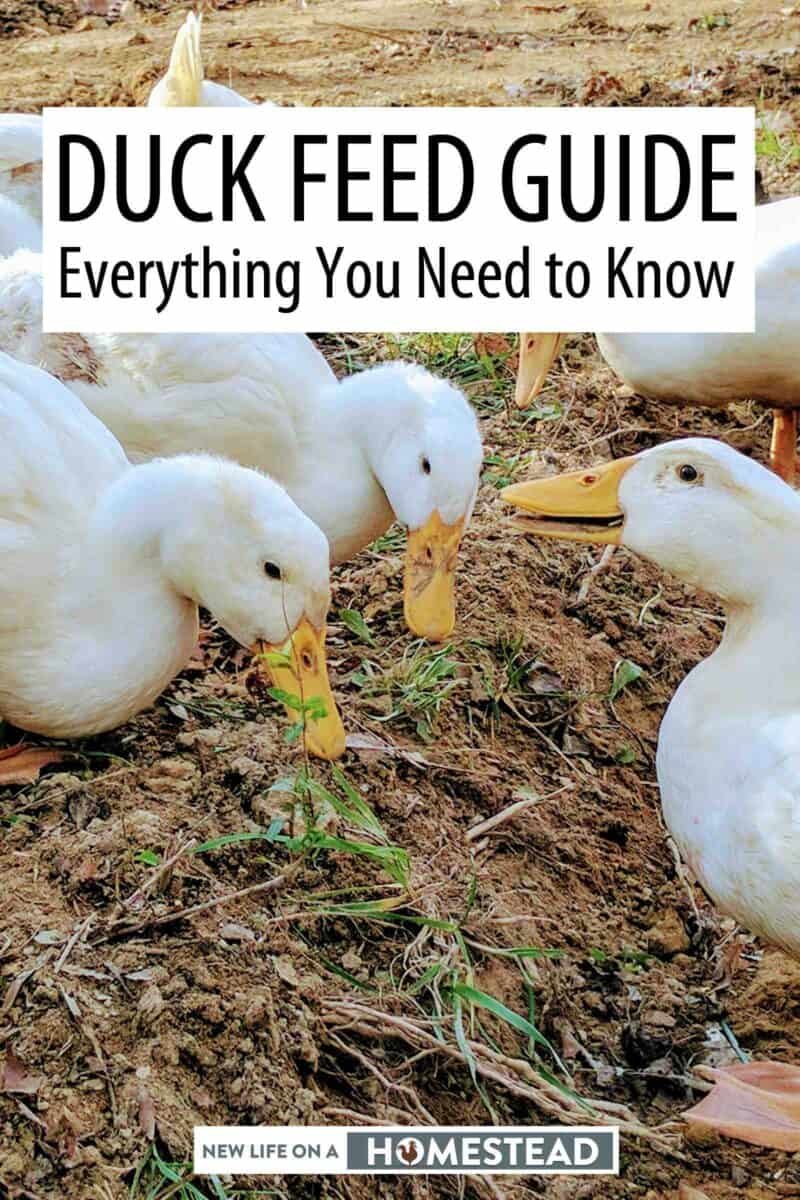

Tara lives on a 56 acres farm in the Appalachian Mountains, where she faces homesteading and farming challenges every single day, raising chickens, goats, horses, and tons of vegetables. She’s an expert in all sorts of homesteading skills such as hide tanning, doll making, tree tapping, and many more.
